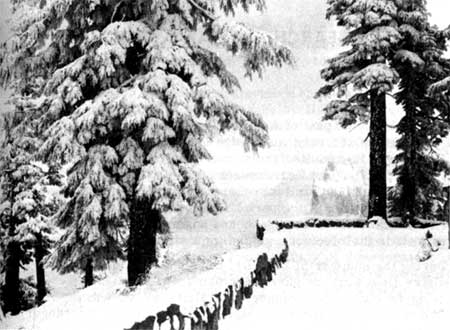|
Volume XVII - 1951
Unusual Bird Records
By Charles F. Yocom, Ranger-Naturalist
POORWILL (Phalaenoptilus nuttalli)
On September 6, 1951, Dr. Donald C. Lowrie and I found a dead
poorwill on the rim road on Dutton Ridge one mile east of Sun Notch at
an elevation of 7250 feet. Apparently this bird had been killed by a car
sometime during the night, for it was quite fresh at 8:30 A.M. when we
found it. The skin was damaged beyond salvation, but the wings and tail
were saved and placed in the study-skin collection at park headquarters.
The blackish area in the middle of the crown, the back of the neck
extensively marked with black, and a dull blackish-gray back suggests
that this bird was a dusky poorwill (Phalaenoptilus nuttalli
californicus). So far as I could learn, Dr. Donald S. Farner
collected the only specimen ever previously reported in the park.
LEWIS WOODPECKER (Asyndesmus lewis)
The Lewis woodpecker migrates through the park each fall. The
following observations record the start of their fall migration for
1951: September 2, one juvenile at 7700 feet of elevation of Llao Rock;
September 6, two adults at 7430 feet near Reflection Point, 20 within
ten minutes at the same elevation near Sentinel Point, and four near
8000 feet at the base of Mt. Scott.
AMERICAN PIPIT (Anthus spinoletta rubescens)
Pipits pass through the park on their way south. I observed them at
higher elevations near the rim as follows: on September 2, three at 8046
feet in a sedge meadow on Llao Rock; on September 6, one at 8938 feet on
top of Mt. Scott and six on the pumice slide on the west slope of this
mountain. On September 3 three individuals, perhaps the same I had seen
the day before, were seen on the very summit of Llao Rock by Dr. R.
Whitaker and Don Holloway of Washington State College, naturalist
assistant Roy Lee Rogers, and the park naturalist.
CEDAR WAXWING (Bombycilla cedrorum)
Few cedar waxwings have been observed in the park. I saw a single
bird on the rim near Sentinel Point on August 12.
BREWER BLACKBIRD (Euphagus cyanocephalus)
Records for this bird within the park are rare although they are
common near Fort Klamath. On September 6, Dr. Donald C. Lowrie and I saw
two. One was seen at 8:30 A.M. hunting insects among the Newberry
knotweeds one-half mile southeast of Sentinel Point. Another was seen at
1:30 P.M. on the pavement west of the Administration Building. A bird
was seen at 7:00 P.M. in the same general area, but this was probably
the same individual seen at noon.
SAVANNAH SPARROW (Passerculus sandwichensis)
I saw three savannah sparrows on the grassy summit of Llao Rock on
September 2. This may be first record of these field-loving birds on
this lofty summit, although the park naturalist informs me that he has
seen them at lower elevations, namely in Copeland Meadows.

The Run in Winter
Special Numbers Of Nature Notes
By George C. Ruhle, Park Naturalist
The Crater Lake Natural History Association is planning a series of
special numbers to fill the demand for information on a variety of
subjects in Crater Lake National Park and Oregon Caves National The
Golden-mantled Ground Squirrel in Crater Lake National Park," is already
in the hands of the lithoprinter. It has been written by former ranger
naturalist Dr. Ralph R. Huestis of the zoology staff of the University
of Oregon. Dr. Huestis was famous for his lodge talks which sparkled
with wit, cleverness of expression, and dependable fact. This product of
his pen, a subject with which he delighted so many park audiences, will
please the reader in similar ample degree.
In this issue, a pen and ink sketch of quillwort has been reproduced
from an original by Dr. Charles Yocom. Dr. Yocom was assigned the task
of drawing 120 different plants of the park and the Caves area this
summer. These will be parts of two small portfolios on popular and
common flowers of these areas. Other brochures will deal with birds,
trees, Indians of the region, and mammals. At the present time, nine
have been prepared or projected for the coming three years.

Winter Scene on the Run
| 
